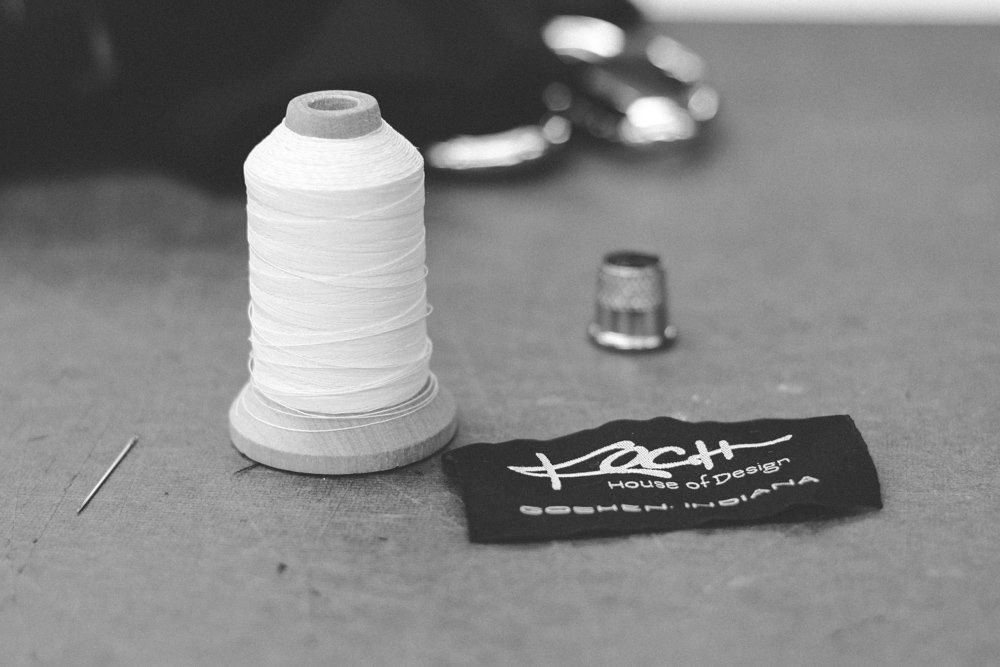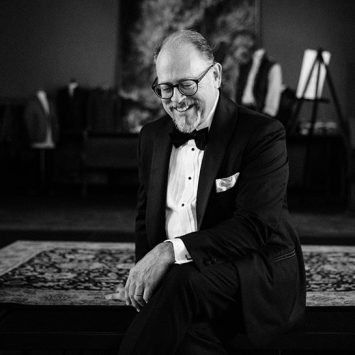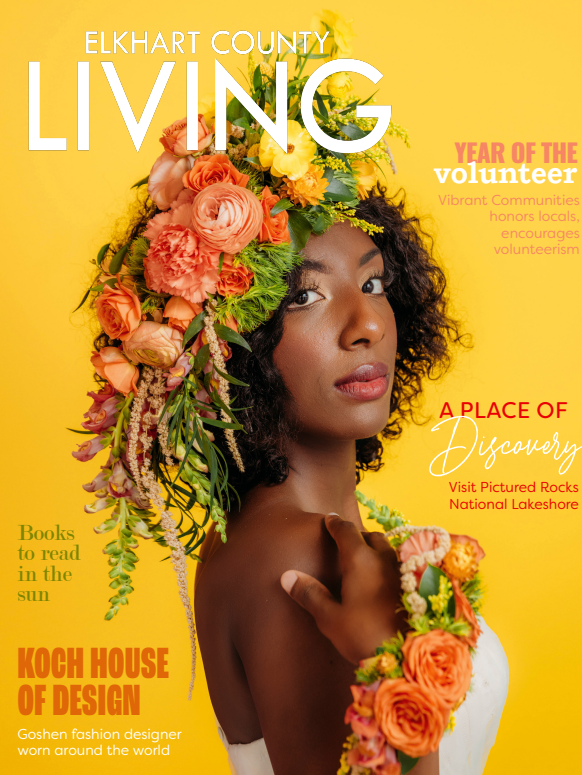The Tailor's Notebook

Originating in 17th century Europe, the term 'bespoke' emerged as patrons personally chose fabrics for their garments. These selected fabrics were then considered "spoken for," signaling the commencement of the tailor's task to meticulously craft a completely personalized piece for the client. In our current era of fast fashion and outsourced production, the concept of bespoke tailoring is often perceived as an ideal reserved for fashion capitals and glamorous runways. Koch House of Design not only challenges this narrative, but actively reshapes and redefines it.

In the summer between my junior and senior year of high school I began doing reupholstery and I learned a little bit about commercial sewing. As a result, when I graduated I secured a job working for a local manufacturing company in Goshen, Jean Lee Originals, which made custom band uniforms and cheerleading uniforms for high schools. Jean Lee was a second generation company that began as the House of Harter, which dealt in sporting goods and had a storefront at Jefferson and Main street. I started out on the line as a sewing operator, but when they discovered that I had majored in Art in high school, they moved me into the embroidery room and also opened the door to a mentorship by their designer, Sonia Love. For 2 years I pushed my curiosity through every department and facet of the company, absorbing everything I could about the clothing and fashion business. Sonia had studied fine art and fashion illustration in Chicago and New York, and eventually lived in Washington D.C., and Louisville as well. She took me very much under her wing and eventually gave me what I consider the most valuable career path advice. Sonia told me a lot of people with no authoritative knowledge or experience will want to give me their advice. She said, that whatever it is you really want to do in life, find someone that has already succeeded at it and learn everything you can from them. Learn from their successes and from their failures. If you want to learn how to make clothes properly, find an apprenticeship with a master tailor. But, I lived in Goshen, Indiana, and my situation did not allow me to move away from Goshen in search of a seasoned tailor. What should I do? So, I began to ask around and low and behold, to my great fortune, I found out that my father once had a custom suit made by a master tailor in Goshen. Enrique San Juan was already past retirement age when I found him above the old Maley’s store on Main street. Henry the tailor, as he was known, had taught and worked with many tailors from various countries before arriving and opening his own Goshen shop in 1956. However, it took several years of persistence and relationship building before he would agree to teach me. And again, fortunately for me, he gave in to my nagging and we had a 22 year relationship before his death in 2004. There is a tradition among master tailors to pass on their sheers to their favored apprentice and successor. In the mid 1990’s Henry bestowed his on me. Now I want to make a clear key point here, and maybe even a challenge. I believe very strongly in the apprenticeship model of education and artisan succession! There is an old African proverb that says, “when an old man dies, a library burns.” When we are not intentionally teaching what we know, our craft will die with us. I encourage you to provide a safe environment for your own craftsmen and tradesmen where they can teach and learn from each other. Look within your place of business for those precious craftspeople. We often complain about the workforce and difficulties in finding “good help” when the answer may already be in our midst. Look within your businesses and factories for someone you cherish and provide a non-threatening venue for them to birth the “good help” that our companies are looking for. As for the products produced by artisans, in a society where things are mass-produced and instantly acquired, there has been little room for carefully crafted, handmade treasures. Yet, I see an enormous hunger building for the renaissance of artisan craftsmanship in this country. Unfortunately, the resources of such craftsmanship are at near-extinct levels. I nearly always have an active apprentice in our workroom. Whether locally from the high schools, or from University level, or enthusiasts of any age. Last year we had a fashion student from FITNY interning and the year before a fashion student from Parson School of Design, also in New York City. We currently have some amazing craftspeople working on staff and we have birthed other artisans into their own businesses and aspirations. If you want to dialogue more about the subject of apprenticeship education, please feel free to contact me directly. I need to talk briefly about the luxury market aspect of my business. Coming from the financially conservative midwest and the surrounding subcultures in which I cut my entrepreneurial teeth, it was rather conflicting for me to embrace a market of luxury and the evils of excess. I would always champion the underdog artisan, but I also felt the need to shun certain aspects of wealth that might appear extravagant to my own community. How could I reconcile spreading the gospel of grassroots artistry for the common man with my heretical passion for making beautifully detailed and costly things? Until one day, the revelation hit me that if the luxury market dies, the artisan dies! We need both. Furthermore, I could not spread my doctrine against disposable consumption without introducing luxury items that are crafted to last far beyond one season! And artistically, how could I look at a world that is created with the extravagant beauty of nature and not be inspired to create beautiful things with my own hands? To be honest many of the things we craft in our workroom are financially out of reach for some people. But if you assess your own private arsenal of techie tools, you will quickly realize that yesterday’s luxury item is now today’s common staple. In my workroom we have coined a new phrase describing the extra details and features we craft into our clothing. We call them “beautifully unnecessary!” I am passionate about details and perhaps the most dramatic change in my artistic expression was that realization. I now know that it is okay to celebrate who I am and what I am passionate about. So creatively, I released myself to aspire to be the Fabergé of clothing and once I did that, things began to come closer to fruition for me. When I am designing, or consulting on design, I am always looking for that inspiration that will take my work far beyond just “good enough.” In design I love to take the humblest common garment and bring it into a place of fashionable glory. This was my thinking behind our AngryAmishJeans line that we have been playfully designing for a couple years now. Similarly, I like to take an extravagant item, such as a decorated military uniform or the formal tuxedo and style it in a way that could be worn casually around town during the day. We did a project for a firm in Kentucky where we made a Carhartt style sport coat that could be worn on the construction site and then directly to the boardroom… Many of you may recognize us as the supplier of Collegiate and Varsity Jackets for some of the local schools and may have even worn Letter Jackets that we made. It may seem strange that we would make jackets that are so far apart in the fashion spectrum from luxury clothing, but it is very intentional. It is important to me that some part of my business touches a need in my home community directly and communicates locally who we are and what we do. When parents bring in their student for a school jacket, they don’t just buy off the rack. They get to experience having a garment made to fit them, from scratch, and even choose some custom options if they like. I enjoy so much seeing them light up when they pick up their finished jackets! It’s some of the most satisfying work I do. I have made suits for Washington insiders and tuxedos for New York’s finest. I have clothed executives from Chicago to L.A. Not bad for a simple tailor from Goshen… I was born and raised in Goshen. Admittedly, I spent much of my life trying to get out of Indiana in fact . But in the end it doesn’t matter if my label is not a household name. Nobody really knew who Fabergé was outside the Royal circles.


